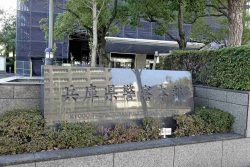13:00 JST, January 18, 2022
Jan. 17 marked 27 years since the Great Hanshin Earthquake. In recent years, there has been a spate of significant earthquakes in various parts of Japan. It is vital to reflect again on the lessons learned from the massive earthquake that claimed the lives of 6,434 people and use them in future measures.
A disaster recovery fund that had helped people affected by the earthquake, an organization established by the Hyogo prefectural government and the Kobe municipal government three months after the disaster, was dissolved last summer. Up to then, the fund had spent about ¥370 billion, including investment proceeds, to help the elderly rebuild their houses and the needy become independent.
The dissolution of the fund may mean that the organization had expended its funds and played a certain role.
In Kobe, the area’s redevelopment is progressing, with twin buildings over 100 meters tall under construction. On the other hand, there are some shopping districts in which customers have not returned to the level of that before the earthquake. People living in temporary housing for affected people are aging, and solitary deaths have been confirmed almost every year.
Recovery in the disaster-stricken areas has been uneven. Necessary support must continue. As increasing generations do not have direct knowledge of the disaster, how to convey the fear of earthquakes is another issue.
Last year in Japan, there were six earthquakes that registered larger than an upper 5 on the Japanese seismic intensity scale of 7. If a Nankai Trough earthquake along the Pacific coasts or an earthquake directly beneath the Tokyo metropolitan area takes place, it is expected that the country could be hit by much larger tremors, with many casualties and huge economic losses.
A big earthquake can occur anywhere at any time. Fire caused by the 1995 Great Hanshin Earthquake and tsunami caused by the 2011 Great East Japan Earthquake led to extensive damage. The central and local governments need to use the knowledge they have gained from past disasters and constantly review whether current measures are sufficient.
After the Great Hanshin Earthquake, the law concerning support for reconstructing the livelihoods of disaster victims was enacted, and a system was introduced to provide up to ¥3 million per household depending on the damage to homes.
Although the system is considered a model of public support for disaster victims, there is also the problem that victims who sustain relatively little damage are not eligible for relief. The government should constantly reexamine how to provide support through the system.
Extensive damage resulted when landslides occurred in developed residential areas on embankments in Nishinomiya, Hyogo Prefecture, during the Great Hanshin Earthquake, and in Nagaoka, Niigata Prefecture, during the 2004 Chuetsu Earthquake.
As a result, in 2006 safety measures were strengthened regarding embankments for residential land development, but land other than residential remains exempt from the regulation.
In Atami, Shizuoka Prefecture, heavy rain caused the collapse of a man-made mound of soil in the mountains last summer, killing many people. The Land, Infrastructure, Transport and Tourism Ministry plans to regulate other types of embankments than those for residential land. Measures must be taken swiftly to prevent damage from occurring again.
Nationwide, there are said to be more than 50,000 large embankments for residential land. It is also necessary to check as soon as possible whether these embankments will collapse due to an earthquake or heavy rain.
— The original Japanese article appeared in The Yomiuri Shimbun on Jan. 18, 2022.
"Editorial & Columns" POPULAR ARTICLE
-

Violations of Subcontract Law: Major Automakers Must Eliminate Old Practices
-

Local Governments’ Tax Revenues: Devise Ways to Correct Imbalances in Tax Sources
-

5 Japanese Business Dinner Mistakes to Avoid — and What They Taught Me About Business in Japan
-

Heavy Rains in Asia: Support for Victims, Flood-Control Measures Urgently Needed
-

Rice Coupons: A Misguided Approach to Countering Rising Prices
JN ACCESS RANKING
-

Keidanren Chairman Yoshinobu Tsutsui Visits Kashiwazaki-Kariwa Nuclear Power Plant; Inspects New Emergency Safety System
-

Imports of Rare Earths from China Facing Delays, May Be Caused by Deterioration of Japan-China Relations
-

University of Tokyo Professor Discusses Japanese Economic Security in Interview Ahead of Forum
-

Japan Pulls out of Vietnam Nuclear Project, Complicating Hanoi’s Power Plans
-

Govt Aims to Expand NISA Program Lineup, Abolish Age Restriction




















